Toro
Diamond Member
My favourite 9/11 conspiracy theory is that it was blown up by thermite. Or is it termites? I can never remember.
Anyways, for anyone who is interested, here is how to destroy a building.
Amazing, isn't it!
Actually, it was the termites that quietly ate away the support structure of the two buildings. Termites don't eat steel, you say? Yes they do. The CIA has been developing Supertermites for just this event.
Oh, wait, was it thermite?
Or holograms.
The people writing this piece are morons.
They probably worked for Popular Mechanics. I heard on the Internet that the author is best friends with a guy who he takes the subway with whose wife knows another woman who has a maid who is sisters with a dog walker of a rich guy who kennels his dogs with the Bushes. Or was it cats? I can never remember.
Or maybe it was a hologram!
Think about it!
Well, I'd go on, but I'm bored now.
Anyways, for anyone who is interested, here is how to destroy a building.
Wow, that sure sounds like a lot of work. It must have taken months to tour the WTC, load up the explosives and take out the support structures. All without any of the 50,000 people who work there knowing.The basic idea of explosive demolition is quite simple: If you remove the support structure of a building at a certain point, the section of the building above that point will fall down on the part of the building below that point. If this upper section is heavy enough, it will collide with the lower part with sufficient force to cause significant damage. The explosives are just the trigger for the demolition. It's gravity that brings the building down.
Demolition blasters load explosives on several different levels of the building so that the building structure falls down on itself at multiple points. When everything is planned and executed correctly, the total damage of the explosives and falling building material is sufficient to collapse the structure entirely, so cleanup crews are left with only a pile of rubble.
In order to demolish a building safely, blasters must map out each element of the implosion ahead of time. The first step is to examine architectural blueprints of the building, if they can be located, to determine how the building is put together. Next, the blaster crew tours the building (several times), jotting down notes about the support structure on each floor. Once they have gathered all the raw data they need, the blasters hammer out a plan of attack. Drawing from past experiences with similar buildings, they decide what explosives to use, where to position them in the building and how to time their detonations. In some cases, the blasters may develop 3-D computer models of the structure so they can test out their plan ahead of time in a virtual world.
Amazing, isn't it!
Those guys in New Jersey sure are stoopid. What took them three years took the Bush-linked government experts in the CIA/FBI/NSA/NHL 10 seconds!According to Brent Blanchard, an implosion expert with the demolition consulting firm Protec Documentation Services, virtually every building in the world is unique. And for any given building, there are any number of ways a blasting crew might bring it down. Blanchard notes the demolition of the Hayes Homes, a 10-building housing project in Newark, New Jersey, which was demolished in three separate phases over the course of three years. "A different blasting firm performed each phase," Blanchard says, "and although all of the buildings were identical, each blaster chose a slightly different type of explosive and loaded varying numbers of support columns. They even brought the buildings down in different mathematical sequences, with varying amounts of time factored in between each building's collapse."
Don't believe any of this nonsense about "support structures" needing to be taken out. That's just gobbledeegook designed to confuse you about what really happened on 9/11.Generally speaking, blasters will explode the major support columns on the lower floors first and then a few upper stories. In a 20-story building, for example, the blasters might blow the columns on the first and second floor, as well as the 12th and 15th floors. In most cases, blowing the support structures on the lower floors is sufficient for collapsing the building, but loading columns on upper floors helps break the building material into smaller pieces as it falls. This makes for easier cleanup following the blast.
Actually, it was the termites that quietly ate away the support structure of the two buildings. Termites don't eat steel, you say? Yes they do. The CIA has been developing Supertermites for just this event.
Oh, wait, was it thermite?
The easiest way to take out the support structures is to hire some scary looking foreigners to fly planes into the buildings.The first step in preparation, which often begins before the blasters have actually surveyed the site, is to clear any debris out of the building. Next, construction crews, or, more accurately, destruction crews, begin taking out non-load-bearing walls within the building. This makes for a cleaner break at each floor: If these walls were left intact, they would stiffen the building, hindering its collapse. Destruction crews may also weaken the supporting columns with sledge hammers or steel-cutters, so that they give way more easily.
Or holograms.
What about thermite? Hello?Next, blasters can start loading the columns with explosives. Blasters use different explosives for different materials, and determine the amount of explosives needed based on the thickness of the material. For concrete columns, blasters use traditional dynamite or a similar explosive material. Dynamite is just absorbent stuffing soaked in a highly combustible chemical or mixture of chemicals. When the chemical is ignited, it burns quickly, producing a large volume of hot gas in a short amount of time. This gas expands rapidly, applying immense outward pressure (up to 600 tons per square inch) on whatever is around it. Blasters cram this explosive material into narrow bore holes drilled in the concrete columns. When the explosives are ignited, the sudden outward pressure sends a powerful shock wave busting through the column at supersonic speed, shattering the concrete into tiny chunks.
Thermite!Demolishing steel columns is a bit more difficult, as the dense material is much stronger. For buildings with a steel support structure, blasters typically use the specialized explosive material cyclotrimethylenetrinitramine, called RDX for short. RDX-based explosive compounds expand at a very high rate of speed, up to 27,000 feet per second (8,230 meters per second). Instead of disintegrating the entire column, the concentrated, high-velocity pressure slices right through the steel, splitting it in half. Additionally, blasters may ignite dynamite on one side of the column to push it over in a particular direction.
The people writing this piece are morons.
They probably worked for Popular Mechanics. I heard on the Internet that the author is best friends with a guy who he takes the subway with whose wife knows another woman who has a maid who is sisters with a dog walker of a rich guy who kennels his dogs with the Bushes. Or was it cats? I can never remember.
Well, that explains the first WTC bombing in 1993. Bush, even though he had just been elected governor of Texas, already knew he'd be President seven years hence - see, he had already bee chosen by the Bilderbergs and the Illuminati - was attempting to take out the structural support of the WTC by planting a van bomb in the garage of the WTC.Blasters determine how much explosive material to use based largely on their own experience and the information provided by the architects and engineers who originally built the building. But most of the time, they won't rely on this data alone. To make sure they don't overload or under-load the support structure, the blasters perform a test blast on a few of the columns, which they wrap in a shield for safety. The blasters try out varying degrees of explosive material, and based on the effectiveness of each explosion, they determine the minimum explosive charge needed to demolish the columns. By using only the necessary amount of explosive material, the blasters minimize flying debris, reducing the likelihood of damaging nearby structures.
Or maybe it was a hologram!
Think about it!
Well, I'd go on, but I'm bored now.






